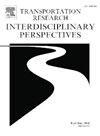Driving on rural roads but crashing on busy roads: A survey study examining non-fatal motor vehicle crashes among U.S. Oil and gas extraction workers
IF 3.9
Q2 TRANSPORTATION
Transportation Research Interdisciplinary Perspectives
Pub Date : 2025-05-01
DOI:10.1016/j.trip.2025.101460
引用次数: 0
Abstract
Transportation incidents are the leading cause of worker injuries and fatalities in the U.S. oil and gas extraction (OGE) industry. This study examined potentially distinct characteristics of motor vehicle crash (MVC) risks among US OGE workers. Seventy-four OGE workers who regularly drive as part of their jobs completed a comprehensive survey, answering questions about driving history, self-rated driving safety and experience, frequency of prior warnings, traffic tickets, near-crashes, and crashes, and attentional and cognitive failures. They also self-reported details of their non-fatal crash events in the past five years, including driver-related, traffic, and environmental conditions and contributing factors. The OGE workers’ non-fatal MVCs frequently occurred 1) in relatively developed areas and on urban and commercial roads, 2) while performing challenging driving tasks such as merging or making left turns, and 3) in situations involving an inability to predict future conflicts, gap judgment errors, and a lack of understanding of traffic rules. OGE drivers at higher risk had shorter licensed years, drove at night frequently, had attentional declines, and drove longer distances. Verbal warnings and traffic citations were ineffective in reducing OGE drivers’ traffic violations and risky driving behaviors. Despite the small sample size, the current comprehensive survey helped uncover the distinct characteristics of U.S. OGE workers’ MVCs, including specific driver performance errors and traffic conditions, which are not monitored by existing surveillance systems. The findings suggest that developing industry-specific interventions and training may be warranted to address OGE workers’ elevated MVC risks.
在农村道路上开车,但在繁忙的道路上撞车:一项调查研究调查了美国石油和天然气开采工人的非致命机动车辆事故
运输事故是美国石油和天然气开采(OGE)行业工人受伤和死亡的主要原因。本研究调查了美国OGE工人中潜在的机动车碰撞(MVC)风险的不同特征。74名OGE员工在工作中经常开车,他们完成了一项全面的调查,回答了驾驶历史、自评驾驶安全和经验、事先警告的频率、交通罚单、险些撞车、撞车、注意力和认知失败等问题。他们还自我报告了过去五年中非致命事故的细节,包括与驾驶员有关的、交通、环境条件和影响因素。OGE工人的非致命性车祸多发发生在:1)相对发达地区、城市和商业道路上;2)在执行具有挑战性的驾驶任务时,如合并或左转;3)在无法预测未来冲突、间隙判断错误和缺乏对交通规则理解的情况下。风险较高的OGE司机执照年限较短,经常在夜间驾驶,注意力下降,驾驶距离较长。言语警告和交通罚单对减少OGE司机的交通违规和危险驾驶行为无效。尽管样本量很小,但目前的综合调查有助于揭示美国OGE员工的MVCs的独特特征,包括特定的驾驶员性能错误和交通状况,这些都没有被现有的监控系统监控。研究结果表明,开发特定行业的干预措施和培训可能有必要解决OGE工人MVC风险升高的问题。
本文章由计算机程序翻译,如有差异,请以英文原文为准。
求助全文
约1分钟内获得全文
求助全文
来源期刊

Transportation Research Interdisciplinary Perspectives
Engineering-Automotive Engineering
CiteScore
12.90
自引率
0.00%
发文量
185
审稿时长
22 weeks
 求助内容:
求助内容: 应助结果提醒方式:
应助结果提醒方式:


